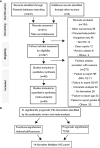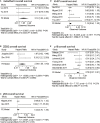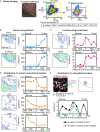A 14-Marker Multiplexed Imaging Panel for Prognostic Biomarkers and Tumor Heterogeneity in Head and Neck Squamous Cell Carcinoma
- PMID: 34490110
- PMCID: PMC8417535
- DOI: 10.3389/fonc.2021.713561
A 14-Marker Multiplexed Imaging Panel for Prognostic Biomarkers and Tumor Heterogeneity in Head and Neck Squamous Cell Carcinoma
Abstract
Recent advances made in treatment for head and neck squamous cell carcinoma (HNSCC) highlight the need for new prediction tools to guide therapeutic strategies. In this study, we aimed to develop a HNSCC-targeting multiplex immunohistochemical (IHC) panel that can evaluate prognostic factors and the intratumor heterogeneity of HNSCC. To identify IHC-based tissue biomarkers that constitute new multiplex IHC panel, a systematic review and meta-analysis were performed to analyze reported IHC biomarkers in laryngeal and pharyngeal SCC in the period of 2008-2018. The Cancer Genome Atlas (TCGA) and Reactome pathway databases were used to validate the prognostic and functional significance of the identified biomarkers. A 14-marker chromogenic multiplex IHC panel including identified biomarkers was used to analyze untreated HNSCC tissue. Forty-five high-quality studies and thirty-one candidate tissue biomarkers were identified (N = 7062). Prognostic validation in TCGA laryngeal and pharyngeal SCC cohort (N = 205) showed that β-catenin, DKK1, PINCH1, ADAM10, and TIMP1 were significantly associated with poor prognosis, which were related to functional categories such as immune system, cellular response, cell cycle, and developmental systems. Selected biomarkers were assembled to build a 14-marker panel, evaluating heterogeneity and polarized expression of tumor biomarkers in the tissue structures, which was particularly related to activation of Wnt/β-catenin pathway. Integrated IHC analysis based on a systemic review and meta-analysis provides an in situ proteomics tool to assess the aggressiveness and intratumor heterogeneity of HNSCC.
Keywords: biomarker; head and neck squamous cell carcinoma (HNSCC); immunohistochemistry; meta-analysis; tumor heterogeneity.
Copyright © 2021 Mitsuda, Tsujikawa, Yoshimura, Saburi, Suetsugu, Kitamoto, Takenaka, Ohmura, Arai, Ogi, Itoh and Hirano.
Conflict of interest statement
HO is an employee for SCREEN Holdings Co., Ltd. KI has received research funding from SCREEN Holdings Co., Ltd. The remaining authors declare that the research was conducted in the absence of any commercial or financial relationships that could be construed as a potential conflict of interest.
Figures






Similar articles
-
Intratumor heterogeneity is biomarker specific and challenges the association with heterogeneity in multimodal functional imaging in head and neck squamous cell carcinoma.Eur J Radiol. 2021 Jun;139:109668. doi: 10.1016/j.ejrad.2021.109668. Epub 2021 Mar 31. Eur J Radiol. 2021. PMID: 33848777
-
BP180 Is a Prognostic Factor in Head and Neck Squamous Cell Carcinoma.Anticancer Res. 2021 Feb;41(2):1089-1099. doi: 10.21873/anticanres.14867. Anticancer Res. 2021. PMID: 33517320
-
A three gene immunohistochemical panel serves as an adjunct to clinical staging of patients with head and neck cancer.Oncotarget. 2017 Jun 19;8(45):79556-79566. doi: 10.18632/oncotarget.18568. eCollection 2017 Oct 3. Oncotarget. 2017. PMID: 29108335 Free PMC article.
-
The prognostic role of PD-L1 expression for survival in head and neck squamous cell carcinoma: A systematic review and meta-analysis.Oral Oncol. 2018 Nov;86:81-90. doi: 10.1016/j.oraloncology.2018.09.016. Epub 2018 Sep 17. Oral Oncol. 2018. PMID: 30409325
-
Quantitative diffusion magnetic resonance imaging for prediction of human papillomavirus status in head and neck squamous-cell carcinoma: A systematic review and meta-analysis.Neuroradiol J. 2019 Aug;32(4):232-240. doi: 10.1177/1971400919849808. Epub 2019 May 14. Neuroradiol J. 2019. PMID: 31084347 Free PMC article.
Cited by
-
CMTM6 status predicts survival in head and neck squamous cell carcinoma and correlates with PD-L1 expression.Discov Oncol. 2024 Dec 4;15(1):745. doi: 10.1007/s12672-024-01554-4. Discov Oncol. 2024. PMID: 39630300 Free PMC article.
-
The role of tetraspanins pan-cancer.iScience. 2022 Jul 19;25(8):104777. doi: 10.1016/j.isci.2022.104777. eCollection 2022 Aug 19. iScience. 2022. PMID: 35992081 Free PMC article.
References
LinkOut - more resources
Full Text Sources
Research Materials
Miscellaneous

